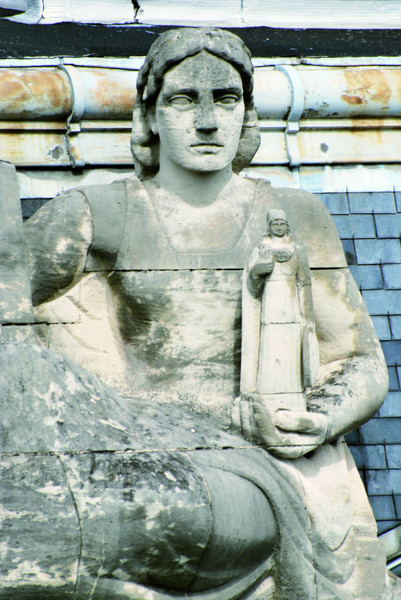

The administrative and social centre

In 1932, in order to meet the new needs of the town, it was decided to build an administrative and social centre comprising administrative services, a reception hall, and a gymnasium. Designed by the architects Chevallier and Launay, this local administrative building was inaugurated on 24 March 1935.
It housed a justice of the peace court until 1995. It also houses two theatres with 800 and 200 seats respectively.
The two sculptures on the pediment are by Claire Colinet and René Collamarini. On the wall of the loggia, above the entrance door, there is a sculpture of the Asnières coat of arms in fragments, by Louis Martin, inlaid in a mosaic made by Hazard.
In the staircase, the "fresco of the nine muses" was painted around 1933 by René Collamarini, originally for the wall above the stage of the main theatre. It was moved to this location on 19 May 1981.
Finally, the life-size "Girl with a Dove" was painted by Louis d'Ambrosio.
The Allegory of Justice

The exterior decoration was commissioned to René Collamarini, who created this allegory of justice, draped and adorned with the symbolic attributes of the law.
Collamarini, who was used to working with architects, had a long career which included monumental works: a bas-relief for the Trocadero, a statue for the Musée d'Art Moderne in Paris (Museum of Modern Art in Paris) in 1936, the École Normale in Pointe à Pitre, and the presidential palace in Abidjan in 1961.
His art was also applied to personalities such as his wife Mona-Dol in 1931, Marshal de Lattre de Tassigny in 1946, and President Bourguiba in 1964.
The Muses
Created to decorate the former reception hall, this bas-relief now adorns the staircase of the theatre inaugurated in 1981 in the Administrative and Social Centre.
In this setting, the Muses, daughters of Zeus and Mnemosyne, goddess of memory, provide divine inspiration. Euterpe is the muse of music, Clio the muse of history, Thalie the muse of comedy and pastoral poetry, Terpsichore the muse of dance and song, Calliope the muse of epic poetry, Polymnie the muse of lyric poetry, Uranie the muse of astrology, Erato the muse of love poetry and Melpomene the muse of tragedy.
A study is currently underway to rethink the building and turn it into a true cultural centre, bringing together theatres, the conservatory, and activity spaces for non-profit organisations.
